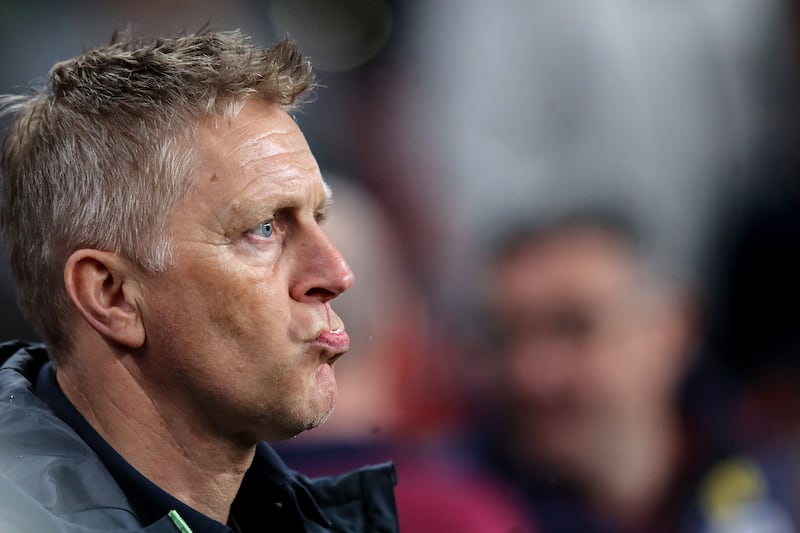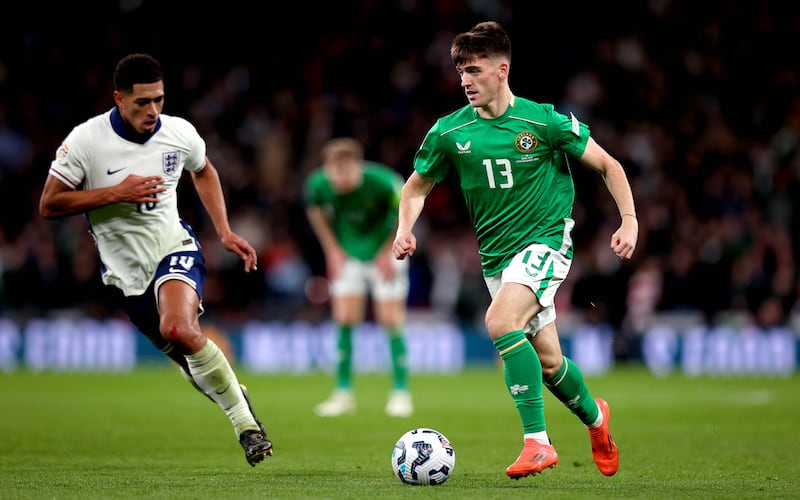The Republic of Ireland’s 5-0 humbling at Wembley last Sunday captured the attention of European football anoraks, for all the wrong reasons. A Polish journalist wrote to this correspondent to learn more about the “crisis” surrounding Irish football.
The first question sounded deceptively simple: “What are the main problems facing the Ireland team?”
The problems are ingrained, we replied, before explaining how Brexit restrictions on Irish teenagers going to English clubs coupled with the FAI’s failure to create an academy system, have fed into one of the most immediate issues – a lack of international calibre midfielders.
“Do you think the FAI are doing their best to find solutions? Do you have any hope that Irish football is moving in the right direction and good years are coming?”
READ MORE
The World Cup qualification campaign over the next 16 months will provide answers as Heimir Hallgrímsson is tasked with transforming a third-seed Uefa country into one of the 16 European qualifiers for North America 2026.
Ideally, a first seed at England’s level and second seed of Greece’s standard are to be avoided in the December 13th draw, but this is unlikely as Fifa currently ranks 27 Uefa members above Ireland.
The World Cup draw will reveal 12 groups with Ireland expected to feature in a four-team bracket that plays six fixtures between September and November 2025. Group winners qualify automatically with 12 runners-up and the four highest ranked Nations League finishers entering a semi-final and final play-off between March 26th and 31st, 2026, to reach the tournament spread across 16 cities in the US, Canada and Mexico.

Ireland’s opponents might not be confirmed until after the Nations League matches in March but Switzerland, Austria or Denmark are top seeds that could conceivably be turned over in Dublin. England, Belgium, Portugal, Croatia, France, Italy, Germany, the Netherlands and Spain are to be avoided.
After resounding defeats to England and Greece, both home and away since September, it is unrealistic for the FAI or the 5,000 Irish fans at Wembley to expect their team to qualify for the World Cup but Wales, Czechia, Romania and even Scotland would be favourable second seeds as they try to make the playoffs.
“It’s tough to say something, to motivate players after this,” Hallgrímsson admitted. “It’s probably better to say less than more. I urged them to look at this game again, look at the positives, look at the negatives and we go from there.”
Ireland should be a tougher proposition in March, when they face a runner-up from Nations League C, that will be revealed on Friday, especially if Andrew Moran continues his development on loan at Stoke City from Brighton. The under-21 captain sounded like a veteran international late on Sunday, having impressed in a 15-minute cameo in place of Josh Cullen.
“I don’t think we can just write this off,” said Moran. “We need to be disappointed about it. I don’t think we should just come here and accept that we are going to lose.
“We need to look back and see what we did wrong so we are ready for the next time; we are going to play teams of this quality in World Cups and Euros [qualifiers], if we want to get there. We need to learn to take points off teams like this.
“When the first goal goes in, as best you can regroup, see it out, kill the game for 10 minutes,” Moran continued. “But it is really difficult with 10 men against a team of that quality, it is easier said than done.”
Narrow victories over Finland, in Dublin and Helsinki, indicate incremental progress under Hallgrímsson, who wants to continually select from a crop of 13 or 14 players. Of the 23 he was forced to start due to injuries across six Nations League fixtures, Caoimhín Kelleher and Nathan Collins mixed outstanding contributions with costly errors. Sammie Szmodics’ commitment to the cause, Festy Ebosele’s penetration down the right and Evan Ferguson’s return to fitness, were also encouraging.
Moran looks primed to join them as a fixture in the team beside Cullen or in a more creative role behind Ferguson.

“Finland was a massive win in itself, as it solidified us as third in the group, so regardless of what happened [against England] we still have the playoffs in March,” he added. “We’ve loads of work to do, we are not the finished article yet.”
The priority is to stop conceding goals after half-time. This comes down to individual discipline and maintaining the structure that frustrated Jude Bellingham and Harry Kane, until the English pair combined to win a penalty off Liam Scales that led to the Celtic defender being sent off. Ireland collapsed thereafter, conceding three goals in six minutes to Kane, Anthony Gordon and Conor Gallagher.
Hallgrímsson has spent the past two months learning about the character and ability of his young squad, when forced to try different combinations due to a high number of injuries.
“It has been a good time for me,” said the manager. “Now, I’ve seen them. It was necessary for me to give them a chance to show what they can do. Andy Moran came into a terrible position. He showed he was confident to play at this level.”
After abandoning the formation used by caretaker manager John O’Shea, following the depressing September loss to England, Hallgrímsson showcased some unorthodox tactics, like using Nathan Collins in midfield and Dara O’Shea at right back.
“You always get answers. Answers are not always how you want them to be. But all answers are good because it moves you forward. It moves you to take decisions going forward. Maybe [the media] knew some of [the answers] but I needed to see all these players going into the World Cup.”
Ireland XIs under Heimir Hallgrímsson
September
Ireland 0-2 England: Kelleher; Doherty, Coleman, Collins, O’Shea, Brady; Smallbone, Molumby; Ogbene, Idah, Szmodics.
Ireland 0-2 Greece: Kelleher; Omobamidele, O’Shea, Collins, Brady; Smallbone, Molumby, Browne; Ogbene, Szmodics, Knight.
October
Finland 1-2 Ireland: Kelleher; O’Shea, Collins, Scales, Brady; Cullen, Knight; Ogbene, Azaz, Szmodics; Ferguson.
Greece 2-0 Ireland: Kelleher; O’Shea, Collins, Scales, Brady; Cullen, Knight; Ogbene, Parrott, Szmodics; Ferguson.
November
Ireland 1-0 Finland: Kelleher; Doherty, Collins, Scales, O’Dowda; Cullen, Knight; Ebosele, Szmodics, Johnston; Ferguson.
England 5-0 Ireland: Kelleher; O’Shea, McGuinness, Scales, O’Dowda; Collins; Ebosele, Cullen, Molumby, Szmodics; Ferguson.
- Sign up for push alerts and have the best news, analysis and comment delivered directly to your phone
- Join The Irish Times on WhatsApp and stay up to date
- Listen to our Inside Politics podcast for the best political chat and analysis
















